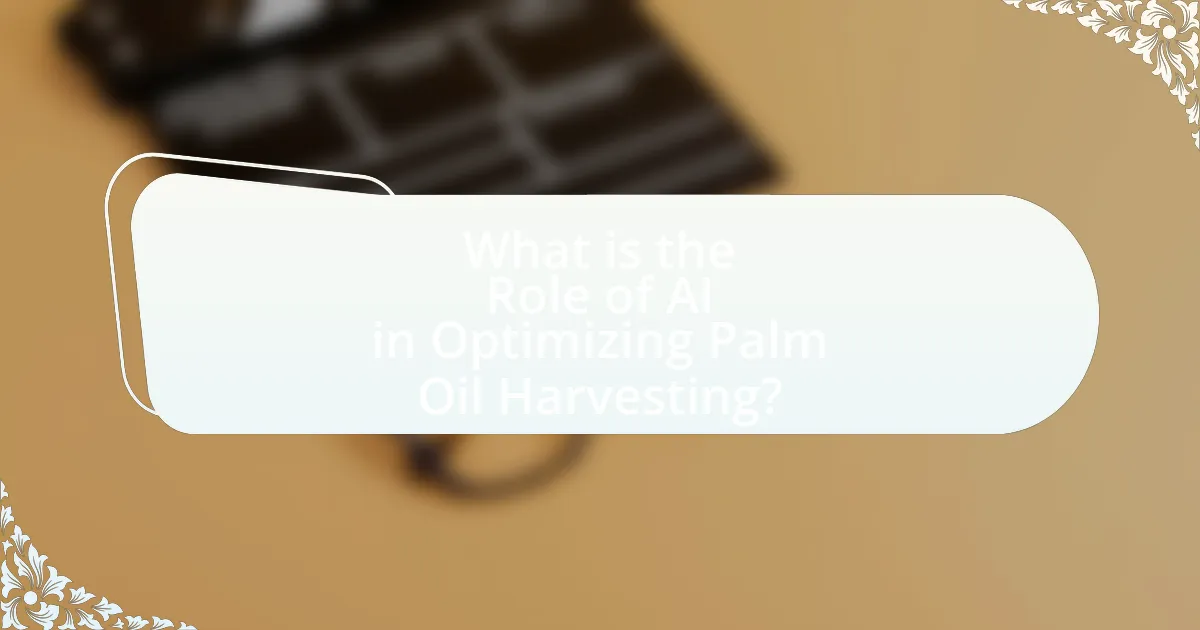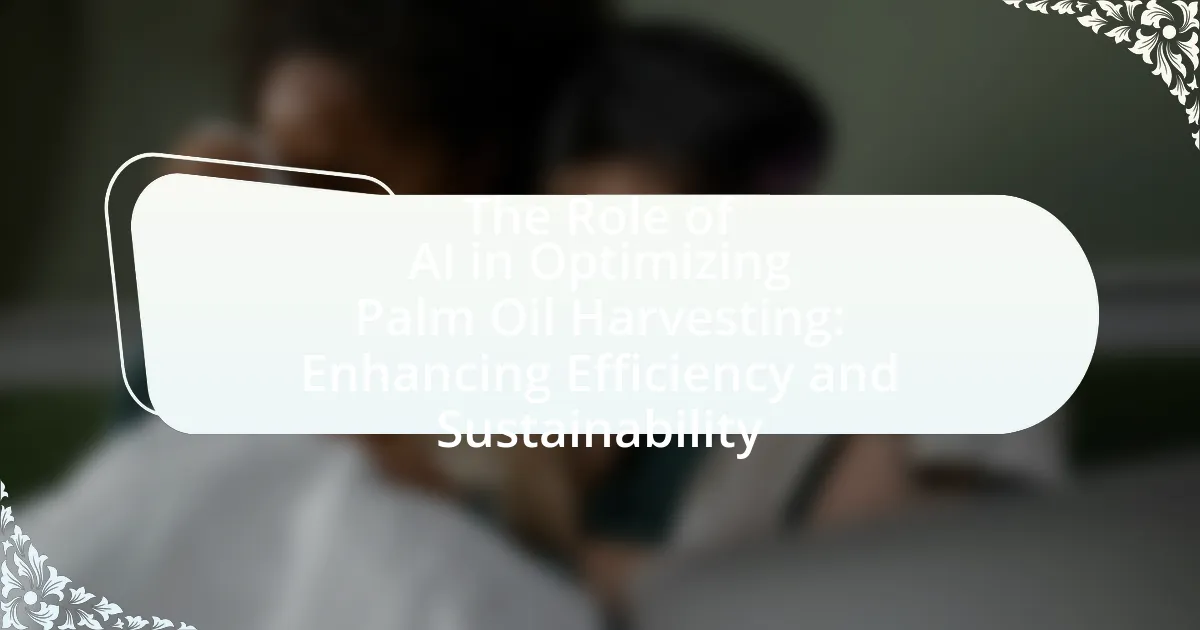The article focuses on the role of artificial intelligence (AI) in optimizing palm oil harvesting, emphasizing its impact on efficiency and sustainability. It outlines how AI technologies, including machine learning algorithms, drones, and predictive analytics, enhance decision-making by analyzing factors such as soil health, weather patterns, and crop yields. The article also discusses specific AI tools used in the industry, the benefits of increased productivity and reduced labor costs, and the importance of sustainable practices to mitigate environmental challenges associated with palm oil production. Additionally, it addresses the technical and ethical considerations of implementing AI in agriculture, providing insights into best practices for farmers looking to adopt these technologies.

What is the Role of AI in Optimizing Palm Oil Harvesting?
AI plays a crucial role in optimizing palm oil harvesting by enhancing efficiency and sustainability through data-driven decision-making. By utilizing machine learning algorithms and predictive analytics, AI can analyze factors such as soil health, weather patterns, and crop yields to determine the optimal time for harvesting. For instance, AI systems can process satellite imagery and sensor data to monitor palm oil plantations, enabling farmers to make informed decisions that maximize yield while minimizing environmental impact. Research indicates that AI applications in agriculture can increase productivity by up to 30%, demonstrating its effectiveness in improving palm oil harvesting practices.
How does AI technology enhance palm oil harvesting processes?
AI technology enhances palm oil harvesting processes by improving efficiency and precision through data analysis and automation. For instance, AI algorithms analyze satellite imagery and sensor data to identify optimal harvesting times and locations, which can increase yield by up to 20%. Additionally, AI-driven drones and robots can perform tasks such as monitoring crop health and harvesting fruit, reducing labor costs and minimizing waste. These advancements contribute to more sustainable practices by optimizing resource use and reducing environmental impact.
What specific AI tools are used in palm oil harvesting?
Specific AI tools used in palm oil harvesting include drones equipped with computer vision for monitoring crop health, machine learning algorithms for predicting optimal harvest times, and automated harvesting machines that utilize AI for precision cutting. Drones can capture high-resolution images to assess palm tree conditions, while machine learning models analyze data to forecast yield and improve decision-making. Automated machines enhance efficiency by reducing labor costs and minimizing waste during the harvesting process. These tools collectively contribute to increased productivity and sustainability in palm oil production.
How do these tools improve efficiency in harvesting?
AI tools improve efficiency in harvesting by automating data collection and analysis, which streamlines decision-making processes. These tools utilize advanced algorithms to monitor crop health, predict optimal harvest times, and allocate resources effectively. For instance, AI-driven drones can assess palm oil plantations, providing real-time insights that enable farmers to target specific areas for harvesting, thus reducing labor costs and minimizing waste. Studies have shown that implementing AI in agricultural practices can increase yield by up to 20%, demonstrating a significant enhancement in operational efficiency.
Why is sustainability important in palm oil harvesting?
Sustainability is crucial in palm oil harvesting because it minimizes environmental degradation and promotes biodiversity. Unsustainable practices, such as deforestation and monoculture, lead to habitat loss for endangered species and contribute to climate change through increased greenhouse gas emissions. According to the World Wildlife Fund, sustainable palm oil production can reduce deforestation rates by up to 50% when adhering to certification standards like the Roundtable on Sustainable Palm Oil (RSPO). This approach not only protects ecosystems but also ensures long-term economic viability for farmers by maintaining soil health and water resources.
What environmental challenges does palm oil harvesting face?
Palm oil harvesting faces significant environmental challenges, primarily deforestation, biodiversity loss, and greenhouse gas emissions. Deforestation occurs as vast areas of tropical forests are cleared to establish palm oil plantations, leading to habitat destruction for numerous species. For instance, the World Wildlife Fund reports that palm oil production is a leading cause of deforestation in Southeast Asia, where over 50% of the original forest cover has been lost. Biodiversity loss is a direct consequence of habitat destruction, threatening endangered species such as orangutans and tigers. Additionally, the conversion of forests to plantations releases stored carbon, contributing to greenhouse gas emissions, which exacerbate climate change. According to a study published in the journal “Nature Climate Change,” land-use change for palm oil cultivation can result in emissions of up to 1.5 billion tons of CO2 annually. These challenges highlight the urgent need for sustainable practices in palm oil harvesting.
How can AI contribute to sustainable practices in palm oil production?
AI can contribute to sustainable practices in palm oil production by optimizing land use, improving yield predictions, and monitoring environmental impacts. For instance, AI algorithms analyze satellite imagery and data to identify suitable areas for cultivation, minimizing deforestation and habitat destruction. Additionally, machine learning models can predict crop yields based on various factors, allowing farmers to make informed decisions about resource allocation and reducing waste. Furthermore, AI-powered sensors and drones can monitor soil health and biodiversity, ensuring that farming practices align with sustainability goals. These applications demonstrate that AI not only enhances productivity but also supports environmental stewardship in palm oil production.

What are the benefits of using AI in palm oil harvesting?
The benefits of using AI in palm oil harvesting include increased efficiency, reduced labor costs, and enhanced sustainability. AI technologies, such as machine learning and computer vision, enable precise monitoring of palm oil plantations, allowing for optimal harvesting times and methods. For instance, AI can analyze satellite imagery to assess crop health and predict yields, which can lead to better resource allocation and reduced waste. Additionally, AI-driven automation can minimize the need for manual labor, addressing labor shortages and lowering operational costs. Studies have shown that implementing AI in agriculture can improve productivity by up to 30%, demonstrating its significant impact on the palm oil industry.
How does AI improve yield and productivity in palm oil plantations?
AI improves yield and productivity in palm oil plantations by utilizing data analytics, machine learning, and precision agriculture techniques. These technologies enable farmers to monitor crop health, optimize resource allocation, and predict yields more accurately. For instance, AI-driven drones and satellite imagery can assess plant health and identify areas needing attention, leading to targeted interventions that enhance growth and reduce waste. Additionally, AI algorithms analyze historical data to forecast optimal harvesting times, which can increase the quantity and quality of the yield. Studies have shown that implementing AI solutions can lead to productivity increases of up to 20% in some cases, demonstrating the significant impact of technology on palm oil cultivation efficiency.
What metrics are used to measure productivity improvements?
Metrics used to measure productivity improvements in palm oil harvesting include yield per hectare, labor efficiency, and operational cost reduction. Yield per hectare quantifies the amount of palm oil produced from a specific area, providing a direct measure of agricultural productivity. Labor efficiency assesses the output generated per labor hour, indicating how effectively human resources are utilized. Operational cost reduction measures the decrease in expenses associated with harvesting processes, reflecting improvements in efficiency. These metrics are essential for evaluating the impact of AI technologies on enhancing productivity and sustainability in palm oil harvesting.
How does AI help in predicting optimal harvesting times?
AI assists in predicting optimal harvesting times by analyzing data from various sources such as weather patterns, soil conditions, and crop health indicators. Machine learning algorithms process historical data to identify trends and correlations, enabling farmers to determine the best time for harvesting to maximize yield and quality. For instance, a study published in the journal “Computers and Electronics in Agriculture” demonstrated that AI models could increase harvesting efficiency by up to 20% by accurately forecasting the ideal harvest window based on environmental factors. This data-driven approach not only enhances productivity but also contributes to sustainable farming practices by reducing waste and ensuring that crops are harvested at their peak.
What economic advantages does AI bring to palm oil farmers?
AI provides significant economic advantages to palm oil farmers by enhancing yield predictions and optimizing resource management. By utilizing machine learning algorithms, farmers can analyze data on soil conditions, weather patterns, and crop health, leading to more informed decision-making. For instance, a study by the International Institute of Tropical Agriculture found that AI-driven precision agriculture can increase palm oil yields by up to 30% while reducing input costs by 20%. This efficiency not only boosts profitability but also promotes sustainable farming practices, as resources are allocated more effectively, minimizing waste and environmental impact.
How does AI reduce operational costs in palm oil harvesting?
AI reduces operational costs in palm oil harvesting by optimizing resource allocation and improving yield predictions. By utilizing machine learning algorithms and data analytics, AI can analyze environmental conditions, soil health, and crop maturity, enabling farmers to make informed decisions about when and how to harvest. This targeted approach minimizes waste and labor costs, as it reduces the need for excessive manpower and machinery usage. For instance, a study by the International Society for Horticultural Science found that AI-driven precision agriculture can increase yield efficiency by up to 30%, directly impacting cost savings.
What is the return on investment for farmers using AI technologies?
Farmers using AI technologies can achieve a return on investment (ROI) of up to 30% to 50% through enhanced efficiency and reduced operational costs. For instance, AI-driven precision agriculture tools optimize resource allocation, leading to significant savings in water, fertilizers, and pesticides. A study by McKinsey & Company indicates that AI applications in agriculture can increase yields by 10% to 20%, further contributing to profitability. Additionally, AI technologies can reduce labor costs by automating tasks, which enhances overall productivity and financial returns for farmers.

What challenges are associated with implementing AI in palm oil harvesting?
Implementing AI in palm oil harvesting faces several challenges, including high initial costs, data quality issues, and the need for skilled personnel. High initial costs arise from the investment required for technology, infrastructure, and training, which can be prohibitive for smallholder farmers. Data quality issues stem from the variability in environmental conditions and the complexity of palm oil plantations, making it difficult to gather accurate and reliable data for AI algorithms. Additionally, the lack of skilled personnel to operate and maintain AI systems limits the effective deployment of these technologies in the industry. These challenges hinder the widespread adoption of AI, impacting the potential benefits of enhanced efficiency and sustainability in palm oil harvesting.
What are the technical barriers to adopting AI in agriculture?
The technical barriers to adopting AI in agriculture include data quality issues, lack of infrastructure, and integration challenges. Data quality issues arise from inconsistent and incomplete datasets, which hinder the effectiveness of AI algorithms. For instance, a study by the Food and Agriculture Organization (FAO) highlights that poor data collection methods can lead to inaccurate predictions and suboptimal decision-making in agricultural practices. Lack of infrastructure, such as inadequate internet connectivity in rural areas, limits the deployment of AI technologies that require real-time data processing. Additionally, integration challenges occur when existing agricultural systems are not compatible with new AI solutions, making it difficult for farmers to adopt these technologies seamlessly. These barriers collectively impede the widespread implementation of AI in agriculture, particularly in optimizing processes like palm oil harvesting.
How can farmers overcome these technical challenges?
Farmers can overcome technical challenges in palm oil harvesting by adopting AI-driven technologies that enhance efficiency and sustainability. Implementing precision agriculture tools, such as drones and sensors, allows farmers to monitor crop health and optimize resource use, leading to increased yields. For instance, a study by the International Journal of Agricultural Technology found that using AI for crop monitoring can improve productivity by up to 30%. Additionally, training programs focused on digital literacy can equip farmers with the necessary skills to utilize these technologies effectively, ensuring they can adapt to the evolving agricultural landscape.
What role does training play in successful AI implementation?
Training is crucial for successful AI implementation as it ensures that the AI system learns from high-quality data, enabling accurate predictions and effective decision-making. In the context of optimizing palm oil harvesting, training involves feeding the AI algorithms with diverse datasets that reflect various harvesting conditions, plant health, and environmental factors. This process enhances the AI’s ability to analyze real-time data, leading to improved yield predictions and resource management. Studies have shown that well-trained AI systems can increase harvesting efficiency by up to 30%, demonstrating the direct impact of training on operational success in agriculture.
What ethical considerations arise from using AI in palm oil production?
The ethical considerations arising from using AI in palm oil production include potential job displacement, environmental impact, and data privacy concerns. Job displacement occurs as AI technologies automate tasks traditionally performed by human workers, leading to unemployment in rural communities dependent on palm oil cultivation. Environmental impact is significant, as AI can optimize production but may also encourage unsustainable practices if not regulated, exacerbating deforestation and biodiversity loss. Data privacy concerns arise from the collection and use of sensitive information about farmers and land use, which could be exploited without proper consent or oversight. These considerations highlight the need for ethical frameworks to guide AI implementation in the palm oil industry.
How does AI impact labor in palm oil harvesting?
AI significantly impacts labor in palm oil harvesting by automating tasks, thereby increasing efficiency and reducing the need for manual labor. For instance, AI-driven drones and sensors can monitor crop health and optimize harvesting schedules, which minimizes labor costs and enhances productivity. According to a study by the International Journal of Agricultural Technology, the implementation of AI technologies in agriculture can lead to a 20-30% increase in yield while reducing labor requirements by up to 50%. This shift not only streamlines operations but also allows workers to focus on more skilled tasks, ultimately transforming the labor landscape in the palm oil industry.
What measures can be taken to ensure ethical AI use in agriculture?
To ensure ethical AI use in agriculture, implementing transparent data practices is essential. This includes obtaining informed consent from farmers for data collection and ensuring that data usage aligns with their interests. Additionally, establishing guidelines for algorithmic accountability can help mitigate biases in AI systems, ensuring fair treatment of all stakeholders involved in agriculture. Research indicates that ethical frameworks, such as the AI Ethics Guidelines set forth by the European Commission, emphasize the importance of human oversight and the need for AI systems to be explainable, which can enhance trust and acceptance among agricultural workers.
What are best practices for integrating AI into palm oil harvesting?
Best practices for integrating AI into palm oil harvesting include utilizing precision agriculture techniques, implementing predictive analytics for yield forecasting, and employing automated machinery for harvesting tasks. Precision agriculture leverages AI to analyze soil health and optimize planting schedules, which can increase crop yields by up to 20% according to studies by the Food and Agriculture Organization. Predictive analytics uses historical data to forecast yields and optimize resource allocation, enhancing operational efficiency. Automated machinery, such as drones and robotic harvesters, can reduce labor costs and improve harvesting accuracy, leading to a more sustainable and efficient palm oil production process.
How can farmers start adopting AI technologies effectively?
Farmers can start adopting AI technologies effectively by first identifying specific agricultural challenges that AI can address, such as crop monitoring or yield prediction. Implementing AI solutions like precision agriculture tools, which utilize data analytics and machine learning, can enhance decision-making processes. For instance, a study by the Food and Agriculture Organization (FAO) indicates that precision agriculture can increase crop yields by up to 20% while reducing resource use. Additionally, farmers should invest in training programs to understand AI applications and collaborate with tech companies to tailor solutions to their specific needs. This approach ensures that AI technologies are integrated into existing farming practices, leading to improved efficiency and sustainability in palm oil harvesting.
What resources are available for farmers to learn about AI in agriculture?
Farmers can access various resources to learn about AI in agriculture, including online courses, webinars, and agricultural extension services. Online platforms like Coursera and edX offer courses specifically focused on AI applications in agriculture, while organizations such as the International Society of Precision Agriculture provide webinars and workshops. Additionally, agricultural extension services often provide training sessions and materials on the integration of AI technologies in farming practices. These resources are designed to enhance farmers’ understanding of AI’s role in improving efficiency and sustainability in agricultural operations.

Leave a Reply